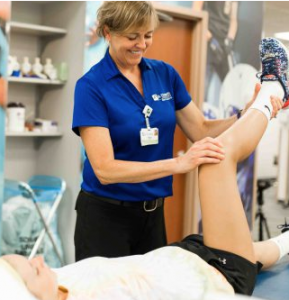You may have never heard of jumper’s knee, or patellar tendinitis, but it is one of the most common knee injuries that can sideline an athlete.
Athletes who do multiple sports, such as soccer and basketball, are at high risk for developing the injury.
Kathy Boehmer PT, MHS, SCS, ATC, Specialty Program Coordinator Sports Medicine, for St. Elizabeth Healthcare, says not only can it be prevented with proper training and rest, if you recognize it early and start rehabilitation, it won’t slow you down for long.

“Jumper’s knee happens with the tendon in the front of the knee has been overstretched or overstressed. There are micro-tears in the tendon, which cause inflammation and can lead to pain,” says Boehmer.
Recognizing Jumper’s Knee
With jumper’s knee, the injury to the tendon may come from the way you land. The injury is common in athletes who frequently jump on hard surfaces. It is considered an overuse injury and comes from the repeated stress of jumping and running.
Symptoms may include:
▪ Pain and tenderness around your kneecap
▪ Swelling
▪ Pain with jumping, running, walking, or using stairs
▪ Pain when bending or straightening your leg
Preventing Jumper’s Knee
“When you jump, many athletes do not land properly,” says Kathy. “The knees collapse, or bend, inward putting more force through the tendon over your kneecap. This may cause micro-tearing which leads to pain and inflammation.”
Learning to land properly at the end of a jump is important. Another key is to strengthen the hips and core muscles with resistance training. By developing these muscles you can help prevent this stress injury. You should also keep your hamstrings and your quadriceps flexible and give your body rest when you feel pain.
Jumper’s knee usually develops gradually, so it is important to get treatment at the first sign of injury.
Treatment of Jumper’s Knee
Boehmer says “if your knee hurts, rest from painful activity is the best treatment. This will give the tendon time to heal. Proper footwear and a patellar tendon strap may also help decrease symptoms.”
Other treatment may include:
▪ Nonsteroidal anti-inflammatory drugs
▪ Elevating your knee
▪ Ice
▪ Physical therapy
Visit this website to learn more.
















